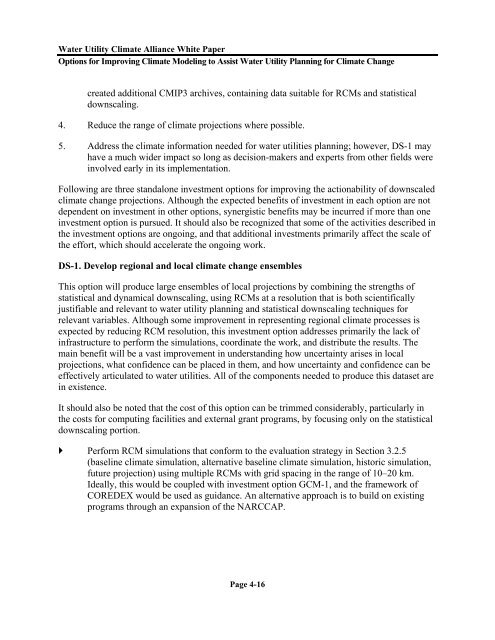Options for Improving Climate Modeling to Assist Water Utility ...
Options for Improving Climate Modeling to Assist Water Utility ...
Options for Improving Climate Modeling to Assist Water Utility ...
Create successful ePaper yourself
Turn your PDF publications into a flip-book with our unique Google optimized e-Paper software.
<strong>Water</strong> <strong>Utility</strong> <strong>Climate</strong> Alliance White Paper<br />
<strong>Options</strong> <strong>for</strong> <strong>Improving</strong> <strong>Climate</strong> <strong>Modeling</strong> <strong>to</strong> <strong>Assist</strong> <strong>Water</strong> <strong>Utility</strong> Planning <strong>for</strong> <strong>Climate</strong> Change<br />
created additional CMIP3 archives, containing data suitable <strong>for</strong> RCMs and statistical<br />
downscaling.<br />
4. Reduce the range of climate projections where possible.<br />
5. Address the climate in<strong>for</strong>mation needed <strong>for</strong> water utilities planning; however, DS-1 may<br />
have a much wider impact so long as decision-makers and experts from other fields were<br />
involved early in its implementation.<br />
Following are three standalone investment options <strong>for</strong> improving the actionability of downscaled<br />
climate change projections. Although the expected benefits of investment in each option are not<br />
dependent on investment in other options, synergistic benefits may be incurred if more than one<br />
investment option is pursued. It should also be recognized that some of the activities described in<br />
the investment options are ongoing, and that additional investments primarily affect the scale of<br />
the ef<strong>for</strong>t, which should accelerate the ongoing work.<br />
DS-1. Develop regional and local climate change ensembles<br />
This option will produce large ensembles of local projections by combining the strengths of<br />
statistical and dynamical downscaling, using RCMs at a resolution that is both scientifically<br />
justifiable and relevant <strong>to</strong> water utility planning and statistical downscaling techniques <strong>for</strong><br />
relevant variables. Although some improvement in representing regional climate processes is<br />
expected by reducing RCM resolution, this investment option addresses primarily the lack of<br />
infrastructure <strong>to</strong> per<strong>for</strong>m the simulations, coordinate the work, and distribute the results. The<br />
main benefit will be a vast improvement in understanding how uncertainty arises in local<br />
projections, what confidence can be placed in them, and how uncertainty and confidence can be<br />
effectively articulated <strong>to</strong> water utilities. All of the components needed <strong>to</strong> produce this dataset are<br />
in existence.<br />
It should also be noted that the cost of this option can be trimmed considerably, particularly in<br />
the costs <strong>for</strong> computing facilities and external grant programs, by focusing only on the statistical<br />
downscaling portion.<br />
Per<strong>for</strong>m RCM simulations that con<strong>for</strong>m <strong>to</strong> the evaluation strategy in Section 3.2.5<br />
(baseline climate simulation, alternative baseline climate simulation, his<strong>to</strong>ric simulation,<br />
future projection) using multiple RCMs with grid spacing in the range of 10–20 km.<br />
Ideally, this would be coupled with investment option GCM-1, and the framework of<br />
COREDEX would be used as guidance. An alternative approach is <strong>to</strong> build on existing<br />
programs through an expansion of the NARCCAP.<br />
Page 4-16

















